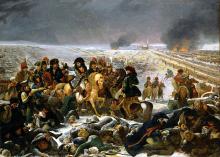- CAC Home
-
About CAC
-
CAC Senior Leaders
Commanding GeneralCombined Arms CenterLTG Milford H. Beagle Jr.Deputy to the
Commanding GeneralCombined Arms CenterMr. Gregg Thompson
Command Sergeant MajorCombined Arms CenterCSM Stephen Helton
Chief of StaffCombined Arms CenterCOL Trent D. UptonCommand Chief Warrant OfficerCombined Arms CenterCW5 Aaron H. Anderson
Deputy
Commanding GeneralCAC ARNGBG Charles MorrisonDeputy
Commanding GeneralCAC USARBG Katherine A. TrombleyDeputy Commanding General - EducationArmy UniversityBG David FoleyDeputy Commanding GeneralCAC - TrainingBG Scott WoodwardDirectorMission Command Center
of ExcellenceCOL Bryan Babich
-
CAC Senior Leaders
-
Organizations
-
CAC HQ
-
CAC Subordinate Organizations
- The Army University (Army U)
- Combined Arms Center - Training (CAC-T)
-
Mission Command Center of Excellence (MCCoE)
- Leadership
- Mission Command Resources
- SharePoint
- Army Joint Support Team (AJST)
- Air Land Sea Space Application Center (ALSSA)
- Combined Arms Doctrine Directorate (CADD)
- Center for Army Leadership (CAL)
- Directorate of Training (DOT)
-
Force Modernization Proponent Center (FMPC)
- Command and Control Integration (C2I)
- Security Force Assistance Proponent (SFAP)
- Contact Us
- Peacekeeping & Stability Operations Institute (PKSOI)
-
Key Partner and Supporting Units
- » Fort Leavenworth Garrison
- » Presidio of Monterey Garrison
- » 902d Military Intelligence Group
- » Munson Army Health Center (MAHC)
- » Joint Center for International Security Force Assistance (JCISFA)
- » U.S. Disciplinary Barracks
- » Community Health Promotion Council (CHPC)
- » Red Team Education
- Contact Us
- Training & Doctrine Command (TRADOC)
- Mission Command Capability Development and Integration Directorate
- 15th MP Brigade
- Centers of Excellence
- Branch Schools
-
Non-Branch Schools
-
Command and General Staff College (CGSC)
- Leaders
- Mission & Vision
- Students
-
Command and General Staff School (CGSS)
- Inbound Class Information
- Department of Distance Education (DDE)
- Department of Command and Leadership (DCL)
- Department of Sustainment and Force Management (DSFM) (Previously DLRO)
- Satellite Campus Program
- Air Force Element (AFELM)
- Navy Element (NAVELM)
- Marine Corps Element (MCELM)
- International Military Student Division (IMSD)
- Contact Us
- School of Advanced Military Studies (SAMS)
- School for Command Preparation (SCP)
- Sergeants Major Academy (SGM-A)
- CGSC Degree Programs
- Registrar
- CGSC News Archive
- Contact CGSC
-
Warrant Officer Career College (WOCC)
- About USAWOCC
- Warrant Officer Program
- Warrant Officer Blackboard Enrollment
- Warrant Officer Courses
- Benefits, Pay, and financial Matters
- Fort Rucker Information
- News/Media
- Retirement/Transition Links
- Warrant Officer Career College Contact Information
- Center for the Army Profession and Leadership (CAPL)
- Western Hemisphere Institute for Security Cooperation (WHINSEC)
- SHARP Academy
- U.S. Army Sergeants Major Academy (USASMA)
- The U.S. Army Inspector General School (TIGS)
-
Command and General Staff College (CGSC)
-
CAC HQ
- References
- Products & Resources
A Costly “Victory” in the Snow: Napoleon and the Battle of Eylau (1807)
By the winter of 1807, Napoleon had defeated – and essentially conquered – both Austria and Prussia in two stunning years of one-sided warfare across Central Europe. Only tsarist Russia remained on the battlefield opposing the French emperor. Though he’d won great victories in recent campaigns, Napoleon was nearly 1000 miles from Paris – with stretched logistical lines - and knew he needed to knock Russia out of the war before his other enemies rearmed. Despite plummeting morale in the army due to brutal winter conditions, the French sought to attack the Russian army in early February.
The Russians knew they were coming – as a copy of Napoleon’s campaign plan fell into enemy hands. After a brief skirmish the day before, on 8 February Napoleon decided to attack the 70,000 Russians with a force of only 45,000 men – counting on the later arrival of Marshal Davout and Ney’s corps to tip the balance in his favor. Thus, Napoleon hoped to employ another classic double envelopment. The emperor ordered a fierce attack on the Russian left and center, but blinding snowfall caused one corps to lose all sense of direction and veer into the fire of their own muskets and cannon. When the Russians counterattacked into the weak French center, Napoleon escaped capture only by the hasty employment of his reserve – the elite Imperial Guard.
On the verge of defeat, Napoleon turned to his 10,000 strong cavalry corps under Marshal Murat, which swept through the Russian infantrymen into their lines of artillery. Though the French horsemen took heavy losses, they staved off defeat and shifted momentum to the French. Just before dark, Marshal Ney finally arrived and briefly hit the Russian left. Although the Russians held their own, Ney’s arrival signaled the end of the battle. The French held the field, but only just. The French suffered 20,000 casualties – the Russians lost a similar number – making this one of the 19th century’s bloodiest battles.
Napoleon claimed victory, but only because his army held the field. Nevertheless, the Russians won a moral victory – holding their own against the best of the French army and inflicting disproportionately heavy casualties. Napoleon’s risky decisions at Eylau demonstrate the importance of strategic context in determining operational decisions. The confusion and disorientation on the battlefield spoke to the ever-present “friction” of war and the necessity for terrain and weather analysis. In the end, French tempo and aggressiveness won the day when so much else had gone wrong. Most of all, however, Eylau proved that Napoleon – even at the peak of his geographic conquests – was fallible and his grande armee was in fact not invincible. This would be proven again in 1812, when Napoleon sought to expand his empire deep into Russia itself.


